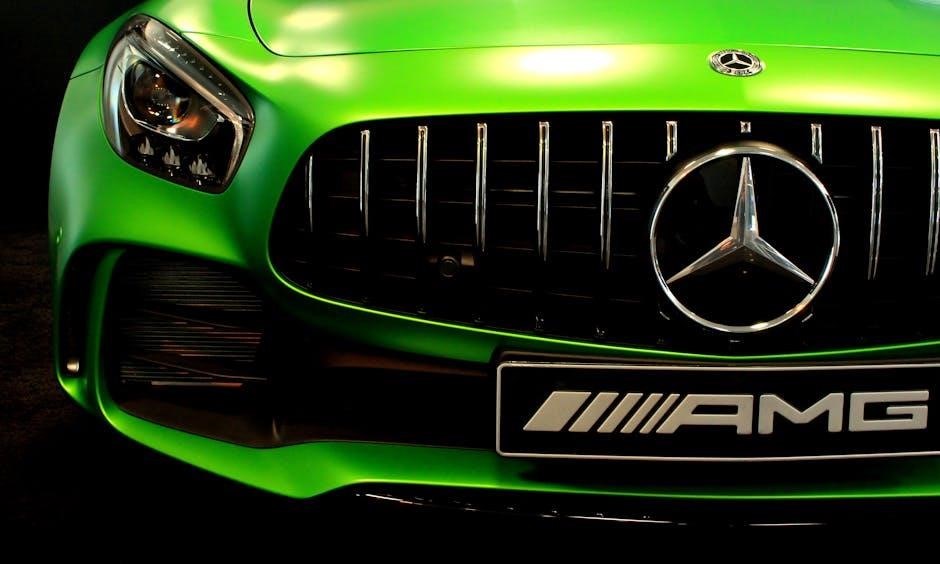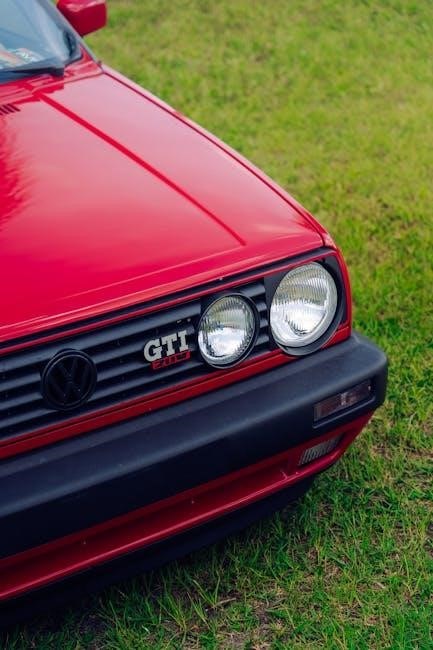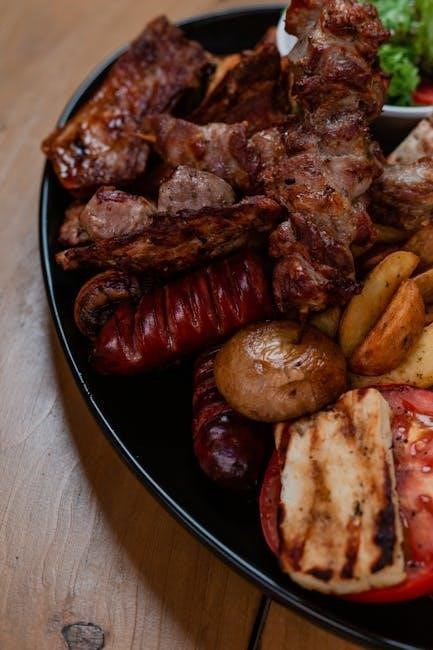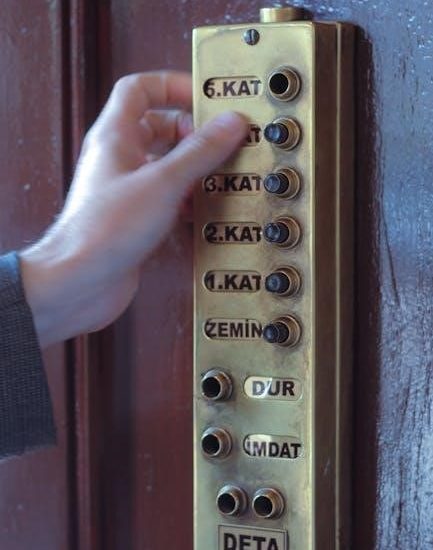expert grill instructions
Welcome to the Expert Grill Instructions guide! This comprehensive resource helps you assemble, maintain, and safely operate your grill. Whether you’re using a gas or charcoal model, this guide covers everything from basic setup to advanced cooking techniques.
Designed for both beginners and experienced grillers, these instructions ensure a smooth and enjoyable grilling experience. Follow along to master your Expert Grill and achieve perfect results every time. Let’s get started!
1.1 The Importance of Following Instructions
Adhering to the provided Expert Grill instructions is crucial for ensuring safety, proper assembly, and optimal performance. Failure to follow these guidelines can lead to potential hazards, such as fire risks or gas leaks, which may result in property damage or personal injury.
These instructions are carefully designed to guide users through each step, from assembly to maintenance, ensuring a seamless and enjoyable grilling experience. By following the manual, you can avoid common pitfalls and guarantee that your grill operates efficiently and safely.
Additionally, adhering to the instructions helps maintain the grill’s warranty and extends its lifespan. Proper assembly and maintenance routines, as outlined, prevent rust and wear, ensuring your grill remains in excellent condition for years.
Always prioritize safety by reading and understanding the instructions before starting any task. This not only protects you but also ensures that your grilling sessions are hassle-free and rewarding.
Key points to remember include handling propane safely, avoiding enclosed spaces, and regularly cleaning the grill to prevent carbon buildup. These steps are essential for a safe and enjoyable grilling experience.
By following the Expert Grill instructions, you can maximize your grilling potential while minimizing risks. Make safety and proper technique your top priorities for a lifetime of delicious meals.

Pre-Assembly Instructions
Before assembling your Expert Grill, ensure you have all necessary tools and materials. Verify the completeness of your parts inventory and prepare a clean, safe workspace.
Double-check the manual for specific pre-assembly steps to avoid delays and ensure a smooth process. Proper preparation is key to a successful assembly experience.
2.1 Tools and Materials Needed
Before starting the assembly of your Expert Grill, gather all necessary tools and materials to ensure a smooth process. Typically, you will need a set of basic tools such as a screwdriver (both Phillips and flathead), an adjustable wrench, and pliers for handling small parts.
A socket set may also be required for certain bolts, depending on the grill model. Additionally, ensure you have a clean, flat workspace to lay out components. For charcoal grills, you may need a wrench for adjusting vents or a tarp to protect your work surface from dust and debris.
Refer to your grill’s specific manual for a detailed list of tools, as some models may require specialized equipment. Organize all parts and hardware (e.g., screws, washers, and bolts) in labeled containers to avoid misplacement.
Lastly, ensure you have safety gear, such as gloves, to protect yourself during assembly. Having everything prepared beforehand will save time and reduce frustration. Always follow the manufacturer’s recommendations for tools and materials to ensure compatibility and safety.
2.2 Verifying Parts and Inventory
Verifying the parts and inventory is a crucial step before starting the assembly of your Expert Grill. Begin by carefully unboxing and laying out all components to ensure nothing is missing or damaged.
Refer to the inventory list provided in the manual to cross-check each item. Pay special attention to hardware such as screws, bolts, and washers, as these are often small and easy to misplace. If any parts are damaged or missing, contact the manufacturer immediately to avoid delays.
For gas grills, inspect the propane components, such as hoses and connectors, for any signs of wear or leaks. For charcoal grills, ensure the cooking grate, ash pan, and vents are included and in good condition.
Organizing the parts by category (e.g., hardware, frames, and accessories) will make the assembly process more efficient. Double-checking the inventory ensures that you have everything needed to complete the setup without interruptions.
Take your time during this step, as it sets the foundation for a smooth and successful assembly experience. Always follow the manual’s guidance for identifying and organizing parts.

Assembly Instructions
Welcome to the assembly section! Whether you’re setting up a gas or charcoal grill, follow the detailed steps carefully. Start by organizing parts, then attach the frame, wheels, and handles. For gas grills, connect the propane components securely.
Charcoal grills require assembling the cooking chamber and vent system. Always refer to the manual or online guides for specific model instructions. Take your time and ensure all connections are tight and safe. Happy assembling!
3.1 Gas vs. Charcoal Grill Differences
Understanding the differences between gas and charcoal grills is essential for assembly and use. Gas grills offer convenience, with easy temperature control and quick startup. They are ideal for those who value precision and minimal cleanup. Charcoal grills, while requiring more effort, provide a rich, smoky flavor.
Gas grills rely on propane, with components like burners and ignition systems. Charcoal grills use coal, needing a venting system for airflow. Assembly varies slightly, as gas grills may involve connecting propane lines, while charcoal grills focus on the cooking chamber.
Both require safety precautions, but gas grills demand attention to leak detection and proper ignition. Charcoal grills need careful ash management. Choose based on your preference for flavor, convenience, and maintenance tolerance.
3.2 Step-by-Step Gas Grill Assembly
Assembling your Expert Grill gas grill requires careful attention to detail to ensure safety and proper function. Begin by unpacking all components and verifying the inventory against the manual. Lay out the parts on a clean, flat surface for easy access.
Start by attaching the wheels and legs to the grill’s base using the provided bolts. Ensure the base is stable and level. Next, install the burners and heat deflectors, securing them firmly to the firebox.
Connect the propane tank to the regulator, making sure the connection is tight and free of leaks. Use a soap solution to test for any gas leaks around the connections.
Attach the cooking grates and warming rack, ensuring they are properly aligned and secured. Install the control panel and knobs, connecting the ignition wires according to the manual.
Finally, test the grill by lighting the burners one by one, checking for even flame distribution. Refer to the manual for specific instructions tailored to your model.
Remember to follow all safety guidelines, such as avoiding open flames near the grill during assembly. Proper assembly ensures optimal performance and safety. If unsure, consult the manual or contact customer support.
3.3 Charcoal Grill Assembly Steps
Assembling an Expert Grill charcoal grill is a straightforward process when followed step-by-step. Begin by carefully unpacking all components and cross-referencing them with the inventory list provided in the manual to ensure no parts are missing.
Start with the base assembly. Attach the legs and wheels to the bottom of the grill body using the bolts provided. Make sure the base is stable and even. Tighten all bolts securely to prevent any wobbling.
Next, assemble the charcoal chamber. Place the charcoal grate inside the chamber and ensure it is properly aligned. Attach the chamber to the main grill body using the screws specified in the manual.
Install the cooking grates by placing them on top of the grill body. Ensure they are securely fastened with the clips or screws provided. Attach the handle to the lid for easy opening and closing.
Finally, assemble the vent system. Attach the air vents to the lid and the bottom of the grill, ensuring they can be adjusted freely. This allows for proper airflow control during cooking.
After completing these steps, double-check all connections and ensure the grill is on a level surface. Your Expert Grill charcoal grill is now ready for use, providing you with a traditional grilling experience.

Safety Precautions
Always follow safety guidelines when using your Expert Grill. Never burn propane in enclosed spaces, as it releases odorless carbon monoxide. Ensure proper ventilation and keep flammable materials away. Follow all manufacturer instructions to avoid fire or explosion risks.
4.1 General Safety Tips
Ensuring safety while grilling is paramount to prevent accidents and injuries. Always position your grill on a stable, heat-resistant surface, away from flammable materials like curtains, leaves, or overhangs. Maintain a safe distance from children and pets to avoid accidental burns or knocks.
Never leave the grill unattended while it’s in use, especially when cooking with propane, as leaks or malfunctions can occur. Use long-handled utensils to handle food, and avoid wearing loose clothing that could catch fire. Keep a fire extinguisher or water source nearby as a precaution.
For gas grills, always check the propane connection for leaks before use. Light the grill according to the manufacturer’s instructions, and never ignite it in an enclosed space to prevent carbon monoxide buildup. For charcoal grills, use lighter fluid sparingly and avoid adding it to hot coals.
After grilling, turn off the burners and allow the grill to cool completely before covering or storing it. Regularly inspect the grill for wear and tear, such as rusted parts or damaged hoses, and replace them as needed;
By following these general safety tips, you can enjoy a safe and enjoyable grilling experience for years to come.
4.2 Handling Propane Safely
Proper handling of propane is crucial to ensure safety while using your gas grill. Always store propane tanks in an upright position, away from direct sunlight and heat sources. Never store them in enclosed spaces like garages or basements, as this can lead to dangerous gas buildup.
Before each use, inspect the propane tank and hose for any signs of damage, such as cracks, dents, or frays. If you detect any issues, replace the damaged parts immediately. Use a soapy water solution to check for leaks in the connections—bubbles forming indicate a leak.
When attaching the propane tank to the grill, ensure the connection is tight and secure. Light the grill according to the manufacturer’s instructions, and never use matches or lighters near an open flame. If you smell gas, turn off the supply immediately and wait for the area to ventilate before attempting to use the grill again.
After grilling, turn off the burner controls and the propane tank valve. Allow the grill to cool before disconnecting the tank. Always follow the manufacturer’s guidelines for handling propane to minimize risks and ensure a safe grilling experience.

Maintenance and Cleaning
Regular maintenance ensures your grill performs optimally. Clean grates and burners after each use to prevent food residue buildup. Deep clean periodically to remove grease and debris. Lubricate moving parts and protect against rust for longevity. Consistent upkeep guarantees a durable and efficient grilling experience.
5.1 Regular Cleaning Routine
A consistent cleaning routine is essential for maintaining your Expert Grill’s performance and longevity. After each use, brush the grates with a wire brush to remove food residue. For gas grills, wipe down the burners and heat deflectors with a soft cloth. For charcoal grills, empty the ash tray and clean out any leftover charcoal dust. Regularly inspect and clean the drip tray to prevent grease buildup, which can lead to fires.
Use a mild detergent and warm water to wipe down the exterior and interior surfaces. Avoid using abrasive cleaners or scrubbers, as they may damage the finish. For tougher stains, mix equal parts water and white vinegar in a spray bottle and let it sit before wiping clean.
After cleaning, dry all surfaces thoroughly to prevent rust. Regular maintenance ensures your grill remains in top condition and continues to deliver exceptional cooking results. By incorporating these simple steps into your routine, you’ll extend the life of your Expert Grill and keep it functioning like new.
5.2 Deep Cleaning and Rust Prevention
Deep cleaning your Expert Grill is crucial for maintaining its performance and preventing rust. Start by disassembling removable parts like grates, burners, and drip pans. Soak these components in a mixture of hot water and mild detergent for several hours to loosen grime. Use a stiff brush to scrub away stubborn buildup.
Rinse thoroughly and dry each part with a clean towel. For rust prevention, apply a thin layer of cooking oil to metal surfaces using a cloth. Alternatively, use a rust-inhibiting spray designed for grills. Reassemble the grill and preheat it to 300°F for 30 minutes to allow the oil to set.
For charcoal grills, remove all ash and debris, then wipe down the interior with a damp cloth. Regular deep cleaning prevents rust and ensures your grill remains safe and functional. By following these steps, you can protect your investment and enjoy years of reliable grilling. Consistency is key to maintaining your Expert Grill’s optimal condition.

Cooking Techniques
Mastering cooking techniques on your Expert Grill enhances flavor and ensures perfectly cooked meals. Focus on temperature control, using direct or indirect heat as needed. Experiment with grilling, smoking, and searing to achieve desired results. Proper food preparation and seasoning are key to unlocking delicious outcomes every time.
6.1 Mastering Temperature Control
Temperature control is crucial for achieving perfectly cooked meals on your Expert Grill. For gas grills, adjust the burner knobs to regulate heat, while charcoal grills require vent adjustments and coal placement. Preheating is essential to ensure even cooking and prevent food from sticking.
Use a meat thermometer to monitor internal temperatures, ensuring food safety and desired doneness. For low-and-slow cooking, maintain a temperature between 225°F and 250°F, while high-heat searing requires temperatures around 400°F. Proper temperature management enhances flavor and texture, making every grilling session a success.
Practice makes perfect, so experiment with different techniques to find your ideal temperature zones. Whether grilling steak, chicken, or vegetables, mastering temperature control will elevate your grilling skills and deliver consistent, delicious results.
6.2 Essential Cooking Methods
Mastering essential cooking methods on your Expert Grill ensures a variety of delicious outcomes. Start with direct grilling for searing steaks, burgers, and vegetables, achieving a crisp exterior and juicy interior. For larger cuts like brisket or pork shoulder, opt for indirect grilling, which uses low heat over time to tenderize meat.
Smoking is another versatile technique, adding rich, complex flavors to meats and fish. Use wood chips or chunks to infuse your dishes with smoky aromas. For a classic outdoor experience, try rotisserie cooking, which evenly roasts meats like chicken or lamb.
Don’t forget grill-roasting for vegetables and potatoes, enhancing their natural flavors with a smoky twist. Always preheat your grill and oil the grates to prevent sticking. Experiment with these methods to explore the full potential of your Expert Grill and create memorable meals.
Whether you’re a beginner or a seasoned griller, these techniques will help you achieve perfection and satisfy any appetite. Happy grilling!
Tips and Tricks
For a perfect grilling experience, preheat your grill 10-15 minutes before cooking. Lightly oil grates with a paper towel dipped in oil to prevent sticking. Use a meat thermometer for accurate temperatures. Experiment with wood chips for smoky flavors and marinate meats for enhanced taste. Keep the grill clean to maintain performance and safety.
7.1 Avoiding Common Mistakes
When working with your Expert Grill, it’s essential to avoid common mistakes that can hinder performance or safety. One of the most frequent errors is not following the assembly instructions carefully, which can lead to improper installation of critical components like burners or vents.
Rushing through the assembly process is another pitfall; take your time to ensure all parts are securely fastened. Neglecting to preheat the grill adequately can result in uneven cooking, so always allow 10-15 minutes for it to reach the desired temperature.
Additionally, many users overlook the importance of regular cleaning, which can lead to grease buildup and rust. Avoid using abrasive cleaners that might damage the grill’s surfaces. When handling propane, never skip safety checks, such as inspecting hoses for leaks or ensuring the grill is in a well-ventilated area.
Lastly, don’t forget to monitor the grill’s temperature closely, as extreme heat can cause flare-ups or char your food. By avoiding these common mistakes, you’ll extend the life of your grill and enjoy a better cooking experience.


